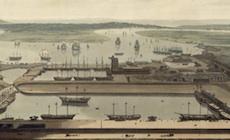In addition to the cotton, tea, and other well-known commodities of the East India Company’s nineteenth-century cargoes, the company was also trading in serpents. These came in many patterns and several grades: venomous, harmless, common, rare. Once in London, the serpents would become, like cotton, a “raw” material for the production of British manufactures, the key ingredients for studies, publications, and exhibitions. Like tea, they were a foreign commodity destined for the booming domestic market in colonial groceries. But unlike cotton or tea, the Company's serpents would not immediately be sold onwards on the London exchanges. Instead, they would be separated out and stored in the cellars of the Company’s buildings in the City of London. From there, they might be sold, traded, or offered as gifts, but most likely they would enter the Company’s growing archive of the nature and industry of the Eastern world. In the basements and display rooms of Leadenhall Street, these snakes and lizards would join space with all kinds of flora, fauna, fossils, minerals, works of art, models, manuscripts, maps, etc. that formed the library and museum of the East India Company.
Though now largely forgotten, in its most active years between c. 1820–70 the library and museum of the East India Company amassed one the most extensive collections on the natural history, arts and sciences of Asia in Europe. In this project, the case of the East India Company’s collections were brought to bear on our understanding of “state science” in imperial Britain. Imperial institutions such as the East India Company and the Admiralty were fundamental to the communication and information infrastructures upon which scientific practice then depended. In what ways did this matter to the making of British science? Through a materially-focused study of the Company’s archives of the East—why they grew, what they contained, how they were used—this project aimed to produce some concrete answers to that question. Such answers were hoped to contribute to a better understanding of how the radical changes within scientific practice in the nineteenth century were (and were not) co-productions of the equally volatile imperial state.
"The Company's Serpents" is part of a larger project, “Archiving the Globe: Maritime Imperialism and Scientific Practice in Nineteenth-Century Britain,” which is funded by a Sackler-Caird fellowship from the National Maritime Museum London.

